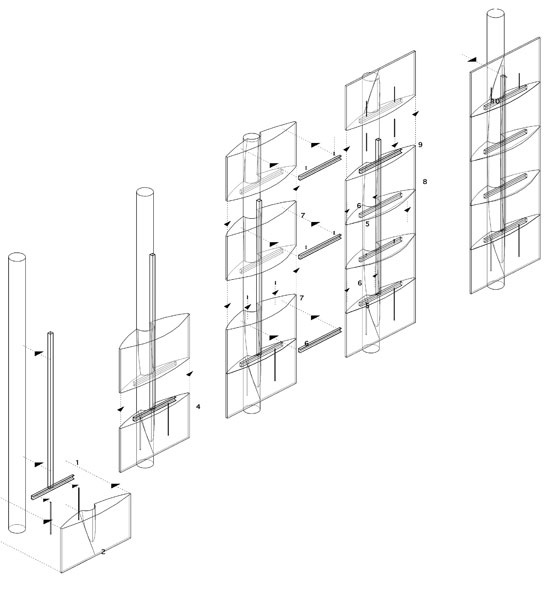Building Information Modeling as a Design Process
BIM During Construction
As a virtual building process, it is easy to see why construction professionals have embraced BIM more quickly than some architects. Three-dimensional visualization of the different systems in a building allows for constructability reviews to take place ahead of time rather than causing delays in the field while techniques are sorted out. Handling construction sequencing and details in the model means onsite workflows can be streamlined. BIM also allows for different systems to be checked for conflicts such as an HVAC duct that is located in the same place as a structural beam. Identifying and correcting conflicts like this on the model ahead of time eliminates a potential time delay and change order request during construction. BIM can also be used by the construction leader to tie directly into time schedules and construction costs by using information in the model to verify quantities and sequences that can be translated into time requirements and pricing finalization.
Perhaps one of the biggest benefits for everyone on the team in using BIM as the basis of design and construction is the streamlined flow of information between all parties. For example, one of the most time-consuming parts of traditional construction period services for design firms is the review of shop drawings and submittals. In a paper-based documentation project, this is the only way a designer can review particular fabrications, products, or materials that are being proposed by the contractor as meeting the drawings and specifications. Of course, these shop drawings are never accepted as a replacement to the construction documents, but they are the detailed basis of building systems such as steel fabrications, millwork, built-in equipment, cabinetry, etc. By contrast, a fully integrated BIM workflow has eliminated the need for shop drawings and submittals in many cases. With all parties involved in advance, the model incorporates the information that would otherwise be created as separate shop drawings.


Images courtesy of Nemetschek Vectorworks, Inc.
The full BIM process constructs the building electronically in the model first, meaning that it already exists virtually, only needing to be actualized in the field.
Taking this one step further, a growing number of design firms incorporate either customized or standardized fabrication into their building designs to fully control some aspects of construction. Modular construction projects are one example where architects and other designers use BIM to create the particular modules that are fabricated and delivered to the site. This form of “digital fabrication” can apply to entire living units, to bathroom or kitchen cores, certain wall assemblies, or smaller components such as cabinetry and finish treatments. In this way, the architect is able to transmit data directly to a fabricator or sub-contractor for direct-to-manufacture processes, thus eliminating any opportunity for misinterpretation or substitutions. At this level, the architect can take control of the entire process by using BIM for design, fabrication, assembly, pricing, scheduling, and overall realization of the project. Architect, author, and educator Richard Garber sees this dramatic advance as the architect evolving out of the 20th century models of practice. He describes the former, traditional approach as going from “possible-to-real”, which relied on construction documents prepared by an architect to be specifically interpreted by a third party such as a general contractor and subcontractors. With BIM in 21st century practice, architects instead embark on a “virtual-to-actual” paradigm in which much interpretation is removed since key data has already been placed in the model. In this sense, a virtual model is already “real” in the computer, only needing to be “actualized” in the field to be made physical.
BIM and Professional Practice
The implications of all of the above aspects of BIM apply to buildings and practices of all sizes. In fact, it is easy to see that a collaborative BIM process allows smaller firms to compete by engaging with other team members electronically focused around a master model and working via the internet with anyone, anywhere. A BIM-focused team can produce very sophisticated designs and documentation without needing a large team of drafters or a lot of extra resources. For larger firms or those with multiple offices, it is easy to see how teams can quickly and easily collaborate and share information, allowing expertise from across the firm to be harnessed in the design without needing to physically move people from one place to another.
Firms that are embracing BIM are finding that it is not about the software or the computer; rather, it is all about a powerfully improved way to practice the process of providing design- and construction-phase services. The AIA has recognized this and now offers contracts that can be tailored as multi-party agreements to allow all parties to benefit financially from a successfully completed project and share more equally in that success. This holistic approach to design and construction that comes about through the BIM process is thus applied in the same manner to all of the stakeholders and the agreement for services.
The design and construction fields have experienced a change in staffing since BIM's emergence. Just as manufacturing in the United States has changed and requires more sophisticated, better educated, and more skilled workers than a generation ago, the same has been observed in the Architecture, Engineering, and Construction (AEC) industry. BIM has helped to alleviate some of the compartmentalization of responsibilities, meaning that there is less need for architects who are separate from designers who are separate from drafters. Rather, since the team is working more holistically, architects or designers may be inputting information directly into a master or architectural model, as well as collaborating to assess and review the outcomes of different iterations. That means that everyone needs to have an understanding of how to construct and design the project so that the information added into the model is relevant, timely, and appropriate to the overall building. At first, this may sound like it is increasing personnel costs, but in reality, it may reduce them by requiring fewer people, albeit with higher skill sets, and allowing the computer to maximize the efficiency of everyone's time.

Photo courtesy of The Design Büro
The implications of BIM on architectural practice are transformative, allowing greater collaboration by designers with more skills and understanding of the construction process, as well.
Design firms can learn some lessons from construction professionals who were the earliest adopters of BIM over any other group in the AEC industry. This is likely because in the real world, contractors recognized huge benefits from using BIM, specifically benefits of saving money and saving time. Contractors have been and still are taking architects' 2D drawings and creating their own building information model from it. That model becomes the tool that they use to first create the building electronically and then in actuality. Design firms can reap the same benefits of time and money savings while receiving the added benefit of enhancing their own design process to develop and create buildings or components that may not have been thought of or been possible before. Further, by retaining control of the master model for a project, the design firm now becomes a long-term partner with the building owner and can continue the working relationship to help with managing the facilities, and monitoring and improving performance. As the need for future alterations, additions, or renovations develop, the master model is in place and up-to-date, allowing for automatic opportunities to design and construct those future needs. The design firm can therefore provide broader services to existing clients and establish a basis for repeat business together.









